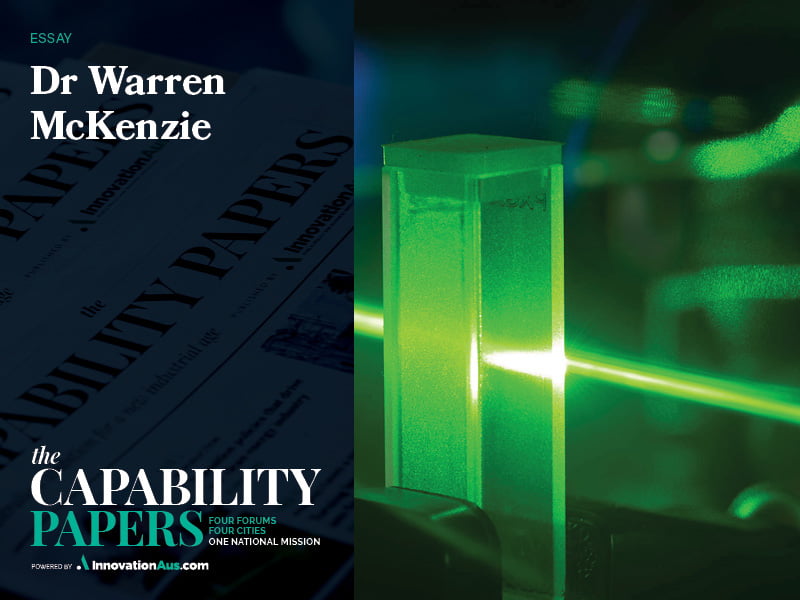The 2018 Nobel Prize in Physics was awarded for a “method of generating high-intensity, ultra-short optical [laser] pulses.” Today these ultra-high-power lasers (UHPLs) have demonstrated many revolutionary technologies that will help to define the 21st century.
The most significant of these is clean energy from fusion, but there are many more. The enormous promise of these technologies has fired the starting gun in a global race to establish next-generation global supply chains for UHPLs.
If Australia moves fast, we can leverage our existing photonics industry and research infrastructure to secure our place in these global supply chains.

We propose a national UHPL industrialisation hub as an internationally unique strategic investment that would capture this opportunity by consolidating our national capabilities and training the new work force.
This initiative would establish a new advanced manufacturing industry. It would also allow Australia to contribute to global initiatives currently being planned by our closest allies.
Ultimately, it would provide an opportunity to diversify our economy and future clean energy mix as we transition to net-zero.
The opportunity: Ultra-high-power lasers and their applications
Unlike conventional lasers that emit a continuous beam of light, UHPLs emit a short pulse of light in a billionth or trillionth of a second like a “big hammer”, to use the words of Donna Strickland, who invented this technology to win the Nobel prize.
Applications range from directed-energy defence, secure communications, many space applications, medical imaging, next generation 3D printing, and finally probably the most important application of our time, clean fusion energy.
Less than a year ago, UHPLs underpinned the National Ignition Facility’s (NIF) historic achievement of fusion net energy gain, which was a giant leap for the next generation of carbon-free energy.
These technological demonstrations are thanks to the research output of about 100 UHPLs that are dedicated to scientific research globally.
However, there is a gap. None of these have the capability to support the industrial development of these applications, which require multi-petawatt pulses at high-repetition rates from purpose-built lasers.
Australia has an opportunity to fill this gap through the establishment of a UHPL industrialisation hub.
Building a UHPL industrialisation hub would enable Australia to leverage its existing capability in the photonics industry, as well as existing research infrastructure, to establish a new advanced manufacturing industry.
Why should Australia take advantage of this opportunity?
UHPL technology is an application of photonics, a field in which Australia has considerable scientific and industrial capability. There are many reasons why we should choose to take this opportunity. Here are a few:
1. We already have an established photonics industry.
From the late 1990s, Australia successfully built a photonics industry that has underpinned high-speed data communications for the internet.
In 2020, the Australia New Zealand Optical Society reported its photonics industry was comprised of more than 500 companies with more than 12,000 employees and contributes $5.4 billion dollars to the Australian economy.
There are 11 significant photonics research centres within Australian universities. Many of these are supported by the research infrastructure within the Australian National Fabrication Facility, which has the capability to prototype many bespoke optical components.
With this local capability, we would expect the majority of components for a next-generation UHPL facility could be manufactured in Australia.
2. It will enable clean fusion energy.
For laser fusion, a field in which Australia has historically led many scientific developments, UHPL is the enabling technology.
Australia’s contribution started with Sir Mark Oliphant, who first demonstrated fusion in the 1930s, including the hydrogen-boron fusion reaction and reported all its benefits, the most significant being that it is aneutronic, making it clean and safe and not a producer of radioactive waste.
The fuel is boron, which is safe and represents the most abundant energy source in the world, if it can be unlocked with UHPL technology.
The invention of laser fusion with boron was undoubtedly made by Australian theoretical physicist and HB11 Energy founder, Professor Heinrich Hora.
In recognition of his work, Hora was the first recipient of the Edward Teller Medal, branding him a pioneer in the field of high energy density physics.
HB11 Energy was established in 2017 to accelerate Hora’s work in the face of the urgent need for a new large-scale clean energy source. HB11 Energy’s global team now includes four recipients of the Edward Teller Medal.
The company has attracted the attention of the US Department of Energy’s (DoE) fusion program, receiving support from one of the first of a series of public-private-partnership (PPP) programs that aim to build the first fusion energy pilot plant within a decade.
3. We have assembled a community
Primarily Australian and driven by a mission to establish “a world-class, sovereign high-power laser industry in Australia”, this group is developing plans to exploit emerging industrial opportunities, establish local manufacturing of key components, and to build on the existing workforce.
It also includes plans to join international programs currently in planning.
4. It would open the door to international partnerships.
A global UHPL industrialisation capability provides an opportunity to translate research outputs from global laser research infrastructure investments via strategic partnerships.
Significant facilities internationally include the portfolios within Laserlab Europe or Lasernet US, or Europe’s Extreme Light Infrastructure (ELI ERIC), which was established by an €850 million investment through European Regional Development Fund.
However, if Australia wants to capitalise on this opportunity, it must move quickly before others do. The following developments have taken place in just the last 18 months:
In the US, the National Academies of Engineering, Science and Medicine published an “Assessment of High Energy Density (HED) Physics” as part of a longer term strategy to maintain leadership in the field of UHPL lasers.
Germany established SPRIND, committing €90 million to the industrial development of “pulsed light technology”, while the Fraunhofer Institute is also developing end user applications for high power lasers.
In relation to the application of laser fusion, Germany has published a “Memorandum for Laser Inertial Fusion Energy” focused on the industrial development of high power lasers as the key to realising fusion energy generation and claiming a significant stake in the evolving industry. In September they also announced a significant increase in its investments into fusion research to more than €1 billion (A$A1.6 billion) over the next five years where magnetic and laser fusion will be equally promoted. This news came the same day as the UK announced additional funding fusion research of £650M over four years adding to the £126M announced less than one year ago ($A1.5B in total).
In the USA, the White House announced a decadal plan to build the world’s first fusion power plant in partnership with the private sector.
To achieve this, the US Department of Energy will make multi-billion-dollar investments through a public-private-partnership (PPP) program based on the NASA COTS model that supported SpaceX and established the commercial space launch industry.
This planning process alone has accelerated the growth of the private fusion industry, with 43 private fusion companies having now raised $9B in private venture capital.
The US, UK, Japan and China have developed or are developing national fusion strategies.
What would success look like?
It may resemble UNSW’s Solar Industrial Research Facility, which has supported the industrial development for the global solar cell manufacturing industry, particularly in China.
We expect it would include the construction of a globally significant UHPL facility. Similar to a synchrotron, key systems could be designed and built by industrial partners.
With primarily Australian content, this would be a platform for the growth of the new industry. It would host proof-of-concept demonstrations for local development efforts.
It would provide a validation service for locally manufactured components and be a training ground for the future workforce.
For HB11 Energy, success for this UHPL Industrialisation Hub would be for Australia to retain the commercial benefits of the great Australian invention of laser boron fusion, should it prove to be the clean energy source that replaces fossil fuels at large.
It would put Australia on the global UHPL map. The Hub would become a magnet for international laser and photonics companies to invest in Australia.
It would also attract invitations for participation in global defence and security missions. For the mission of fusion energy, this hub could be a part of the US plan to build a fusion power plant within a decade in partnership with the DoE and the private sector.
These fusion public-private-partnership programs are the most likely commercial pathway for HB11, or any other fusion startup, to build a pilot fusion power plant.
Dr Warren McKenzie is an Australian scientist and entrepreneur. His experience spans the fields of nanotechnology, semiconductors, metallurgy, gene therapy and now fusion energy with each venture holding the possibility of being world changing. As an entrepreneur, Dr McKenzie has been listed as one of Australia’s top 100 Innovators. As an academic, he holds a position at the UNSW School of Materials Science and Engineering and is a Fellow of the Royal Society of New South Wales. Dr McKenzie founded HB11 Energy with a global pioneer of laser fusion, Emeritus Professor Heinrich Hora.
Do you know more? Contact James Riley via Email.

